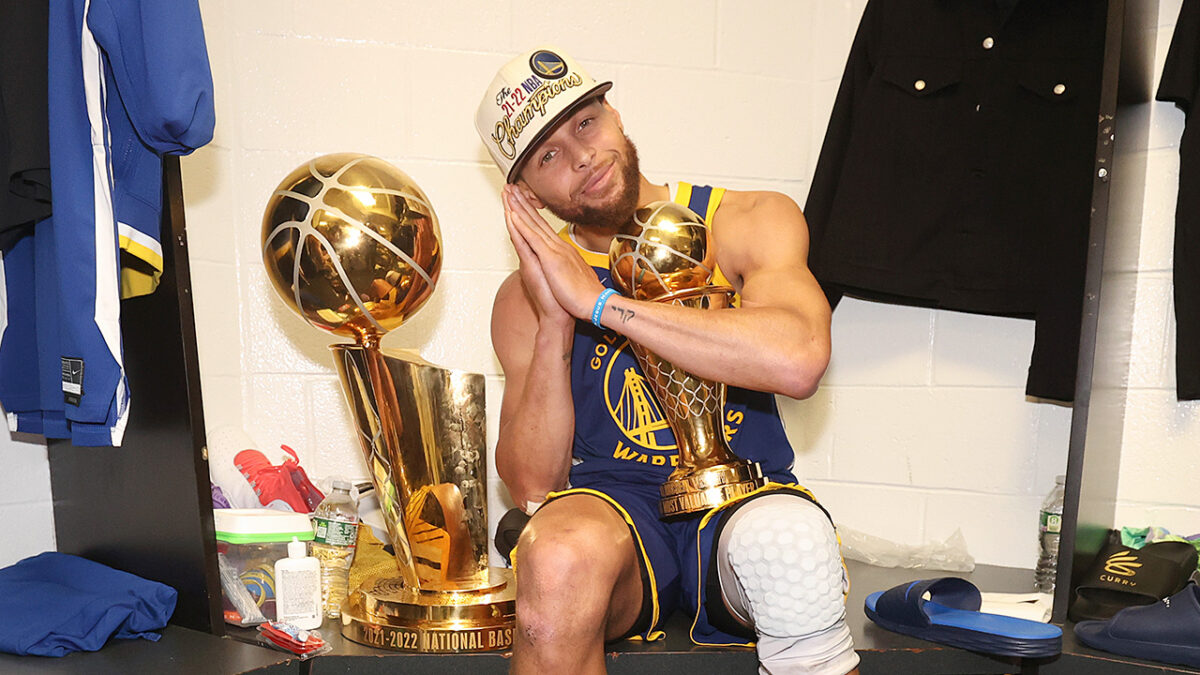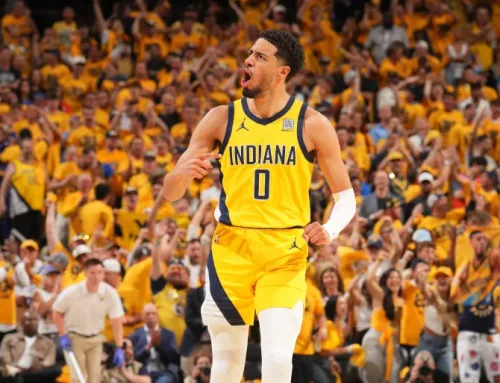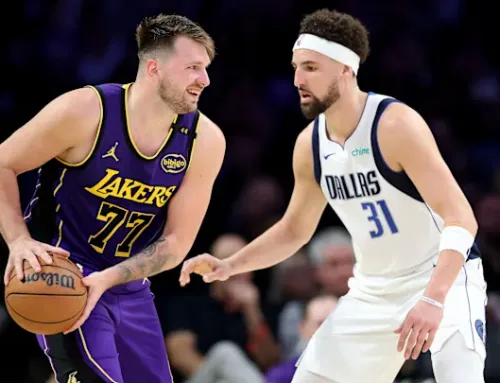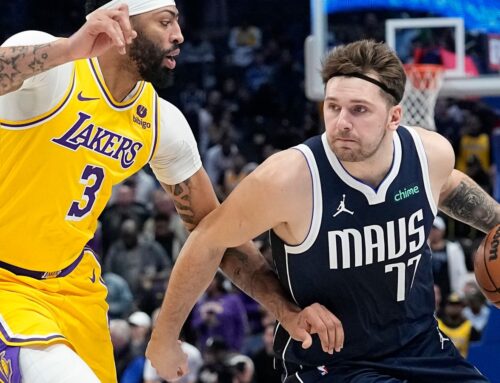The Remarkable Stephen Curry
By: Avi Tyagi

BOSTON, MA – JUNE 16: Stephen Curry #30 of the Golden State Warriors celebrates with the Bill Russell NBA Finals MVP Award after Game Six of the 2022 NBA Finals on June 16, 2022 at TD Garden in Boston, Massachusetts. NOTE TO USER: User expressly acknowledges and agrees that, by downloading and or using this photograph, user is consenting to the terms and conditions of Getty Images License Agreement. Mandatory Copyright Notice: Copyright 2022 NBAE (Photo by Nathaniel S. Butler/NBAE via Getty Images)
It feels weird to call one of the most popular players in the league underrated, and yet in some ways, it’s true. The skinny little point guard from North Carolina entered the mainstream conscious not through star-studded performances on one of the college powerhouses residing in that state, but for his one-man show performances from Davidson. He has always been doubted perhaps more unfairly than any other star of this era. It’s easy and perhaps too convenient to trace it to the unorthodoxy of his style of play, to the benevolence of his approach, and of course as it often is, to his slighter frame. In a league that frequently promotes its big wings and promotes each of its stars as a unique singular irreplicable entity, perhaps Steph is the only one who fits that bill truly. Even in college, he was oft criticized for a lack of aggression during games with lower scoring totals, despite those often stemming from a willingness to allow teammates to attack the 4 on 3s created by his gravity. Like clockwork, every year those same patterns have emerged to cause voters, audience members, and media members alike to overlook Steph in one award or another almost year over year. I don’t want to relitigate awards too frequently, but it worth remembering how often this pattern occurs. In 2012-13, the best player far and away on his own team was not selected to represent the Warriors for the All-Star game, instead, David Lee was. That was not just because of some positional designation either; Zach Randolph and Russell Westbrook were the two wild cards. Randolph could have taken a forward spot and Curry could have earned a well-deserved selection. It would have been easy for a rising star like Steph to bristle and promote internal strife at being swept aside as second-best when he was clearly the tide that raised all boats. As anyone who has watched Steph knows, that has never been how he operates. It speaks to the understated leadership and quality of his character, to always truly be team-first. What did he do after being discounted? Simply raise his game further. Before the 2013 All-Star break, on a steady diet of difficult isolation shot making without the use of off-ball sets or the heavy motion offense we know from the Warriors today, Steph averaged 21 points and 6.6 assists on 56.7% true shooting (around 3% above the league average that season). Post-break, Steph jumped to 7.4 assists and 26 points per contest on a scorching 62% true shooting. Most of that growth was driven by his increased comfort within the arc and by craftier finishing at the rim as a primary attacker. Additionally, he increased his per-minute 3-point shot volume by 20%. That full package led to a season-long 58.9% true shooting percentage.
Let’s have fun with a statistical nugget. Here is a list of some modern superstars with at least 5 seasons played (so Ja, Luka etc. are excluded) who have never hit that 58.9% mark once in their careers (it’s frankly unfair to go any far further back in league eras to compare raw true shooting numbers): Russell Westbrook, Blake Griffin, Carmelo Anthony, Demarcus Cousins, Tony Parker, Zach Randolph, John Wall, CJ McCollum, Fred VanVleet, Dwayne Wade, Donovan Mitchell, Brandon Ingram, Kemba Walker, and notably Jayson Tatum and Jaylen Brown. There are a countless number of other players who have only exceeded that threshold once in their career such as Middleton, Siakam, Lamarcus Aldridge, Paul George, Ben Simmons, and Devin Booker. That true shooting figure would be 4th best in the league amongst all guards with a usage rate over 20% this season (*topped only by Trae, Kyrie, LaVine, Poole). 58.9% is the second lowest of Steph’s entire career. Only his rookie season was lower. Now, to be abundantly clear, true shooting percentage is not suggesting that none of those aforementioned scorers are quality offensive players. Perhaps a different context or smaller offensive role may boost that statistic for them, and there are different contextual elements or other strengths of their game that would not just be captured by one base statistic. You can file this info away in a cabinet somewhere, as a symbol of the ruthless efficiency with which Steph scores even compared to many of his all-star brethren. Even compared to most players who annually comfortably approach the 60% true shooting threshold, Steph has always done it different.
What if I told you that Chef Curry, owner of countless 3-pt records, has never once made more than 91 catch and shoot 3 pointers? Deni Avdija and Ayo Dosunmu made more catch and shoot 3 pointers this past season (per NBA tracking data) than Steph has in any single season. That’s unique in itself, but many primary scoring maestros have delved further and further into mastering the pull-up step back as their 3 of choice. Steph has too, only it’s supplemented the arsenal of 3s that have long set him apart. You know the ones, the high and pick and rolls, only hold on, wait there’s a second screen … ok that was weird we have that covered, ok now there’s a post entry, let me see what’s happening th… oh no. One pin down screen later, one Stephen Curry is wide open for a 27-footer. Maybe some of you can even visualize this image, with Draymond as one of the focal points and Klay roaming on the weak side, distracting defenders with movement of his own and presenting another possible option if the first attack is shut down. In every season (excluding the 5-game hand-injury stint), Steph has made at least 30 shots in each of these play types as designated by NBA.com tracking: off of screens, cuts, spot ups, and handoffs. Keep in mind, this is while being top 4 in total pull-up 3s made in every season since 2013-14 (excluding 2017-18 where the team fizzled during his missed 30 games and the above-mentioned hand-injury season). The first 3 years, he made over 50% more pull-up 3s than second place did and at a scorching 42% overall. He would likely have been a league leader in 2012-13 too if that data were publicly available. Back to the topic, we were talking about Steph being underrated.
When I originally wrote this, I segued into breaking down every year of Steph’s career and compared each to that of another high-profiled star who gained more recognition during awards season (perhaps driven by my disbelief at Steph not being recognized as Doncic’s backcourt mate on the 2022 All-NBA First Team). I went series by series for the 2016-2019 Dubs playoff performances. I was creating a ruckus over how Steph’s offensive arsenal as an on-ball scorer, off-ball scorer, and passer made him the most devastating threat on those teams in the entirety of every playoff run, even if small-sample shooting stretches (on an easier array of shots thanks to Steph) often swung the narrative spotlight to teammates. There was more than one mention of the understated injuries and the underbaked bench units in that stretch. Frankly, those just diverted the positive attention from Steph and invested far too much ink to nitpicking competitors and teammates. Instead, I’ll keep it simple. Let’s talk about defense.
Chef Curry has always been one-of-a-kind at demoralizing opponents with back-breaking 3-point runs. Where he has also always separated himself from most of his guard counterparts, shockingly to some, is on defense. This is not to say that Steph has been a positive defender, or even a true positive as a guard defender. Steph has always been an above-average defender for a superstar offensive guard. That might not sound like a high bar to clear (and it really isn’t), but for a Warriors defense with consistent championship aspirations, it made the difference year after year. On a team with functional defensive big men year over year, excellent wing defenders such as Iggy, Klay, and of course multi-time DPOY Draymond, all Steph has ever needed to be is serviceable. Early in his career, that standard was met by being consistently aware that he would be hunted and by quickly hedging and recovering or switching out of any actions to escape. Of course, when LeBron James spends 4 NBA Finals in a row specifically selecting Steph as the mismatch on a team with Draymond, Klay, Iguodala, Bogut, Looney, Livingston, and Durant, the spotlight in the highest-level playoff environments quickly increased scrutiny on his defense and lowered consensus opinion. Combine that with the frame, and it became easy to refer to him as a sieve. That has never really been the case. While Steph has had a history of ball watching or overeagerly swiping at air, and while a younger Steph truly was exploitable in pure isolation matchups, he’s always given more than enough effort compared to his star counterparts. His strengths have always been harder to quantify: communication, effort, recognition, speed, hip flexibility, and lateral agility. Many a Warriors top-3 defense has escaped danger because Steph recognized the action and hid himself out of the play. His hedge and retreats have always worked better than it would for most guards because his footspeed, stamina, and ability to quickly change directions on offense also help him find a safe corner on the court. He might have been consistently protected, but by consistently communicating with his coaches and star defenders, he’s also at partially responsible for that outcome. Not every guard has the capability to protect themselves in that way. Most offensively oriented guards are truly sieves on that end, with limited defensive playmaking to speak of and few strengths on that end. Steph is active in passing lanes and has decent hands for steals when he’s attacking with purpose rather than out of desperation. Those skills have become even more valuable with his dramatic improvements last season. At the start of the 2022 regular season, the years of improved strength and conditioning that reflected onto Steph’s frame finally started paying massive dividends. Within the first 30 games of the regular season, Steph was creating plays as a true positive guard defender, not with any caveats about superstar offensive ability. His defensive growth, which drew praise at the time, slowly faded into the background as the team faded in intensity in the dog days of the season.
In real NBA playoff games, Steph was able to hold his own in isolation or once switched onto primaries and physically not get shoved aside. Say what you want about the Celtics, but that roster torched many a guard in the Eastern Conference playoffs into being absolutely unplayable defensively (I won’t name names because it’s uncharitable and you know who they are). Even within this series, the offensive lightning storm that is Jordan Poole struggled far more frequently at containing opposing ball handlers and frequently presented openings for the Celtics to attack. Not Steph. Matched up against the physically imposing and crafty Marcus Smart for most of the series, Steph held his ground enough times when in isolation so as to not stress test the defense. Plays like these (https://go.nba.com/kgrh3) against Jaylen Brown made a massive difference throughout the series. Emblematic of the Finals in total, the Celtics dribbled into the heart of the paint and into the awaiting arms of several Warriors help defenders, leading to scrambled passes that fluttered out of bounds or worse, into the hands of Steph Curry to run transition offense on the other end. That’s not to say that Steph wasn’t still the apple of the Celtics’ eye on defense at times or that he didn’t concede many dribble drive opportunities. The difference was the notable decrease in the volume of drives conceded. On most possessions, particularly when the Celtics considered bashing through Steph to wear him down as a real strategy and as an easy source of points, he rarely conceded his ground by a significant margin. Even power drives with an initial head start did not concede the sort of advantages that they might have in the past. Steph’s focus appeared to be on preventing clear two-v-ones, rotating behind the play to stopper any advantages, and reading the passer’s vision to generate steals and transition buckets. It might be reductive to boil this series down to the difference in transition effectiveness, but the Warriors led by a sizeable margin in an otherwise close series.
Ultimately, it was the combination of that defense with an effervescent offensive performance that made this a true statement win, even for a player of Steph’s caliber. While the Human Torch had previously lit up excellent playoff defenses in spectacular fashion (the 2016 Thunder, 2017 Spurs, and 2019 Raptors come to mind, the Celtics defense was a unique test. The Celtics were the first elite, zenith-of-the-mountain defense built on the fearsome prowess of its perimeter defenders. Smart, White, and Brown were the laboratory ideals for hounding Steph around the court while Grant Williams and Horford were two of the best switching big men in the league last season. The most dominant defense over the last half of the season, the Celtics had physically held up with each superstar from the prior rounds. In his younger years, there were times that Steph’s scrawny frame let defenders knock him off his spot and force easier turnovers. His power dribble was still developing, not yet strung like a Yo-Yo on his fingertips. Even a healthy 2017 Steph had turnovers such as these: https://go.nba.com/y4srk, https://go.nba.com/dpd58, and https://go.nba.com/mg7gd. While he had already cleaned up many of these errors over the past few playoffs, the Celtics series was perhaps the most pristine series of his career. The physical growth that prompted a defensive leap in the regular season also cultivated the most dynamic, devastating version of Curry offensively: https://go.nba.com/fui9s and https://go.nba.com/39ki4. Play after play, no matter how physical the Celtics got, Steph dusted defenders for drives to the cup, especially Horford. Poor Al played Steph to almost perfection and it didn’t even matter: https://go.nba.com/67gvf and https://go.nba.com/hyonv. These are only a few scattered clips that don’t even include kickouts or offensive possessions altered by successful paint touches by Steph. That utter dominance culminated in a 4th ring, a legacy reaffirming moment, and perhaps the best playoff series in his illustrious career.
The discourse following the last few playoffs has slowly created a new offseason award. There is MVP, there is Finals MVP, and now we even have Conference Finals MVP, but those are not the award I am referring to. That contemporary narrative award, the title given to players regardless of the result, is Best Player in the World. For years, despite multiple MVPs, Steph never warranted consensus consideration for that accolade. With the afterglow of the Finals burning bright every year as the league calendar flipped over, the jumbo wings inhaled all the oxygen. In the jubilant atmosphere exuded by the Bay Area’s finest, in the immediate aftermath of Draymond rightly dubbing the NBA Finals “The Warriors Invitational”, with a Finals MVP in hand, and with every other contestant for that award this cycle either suffering defensively in a short playoff stint or being pummeled on offense by one of the league’s best defenses (The Celtics or Heat), I think it’s time for Steph, the leader and foundation of the GSW Dynasty, to bask in the offseason sun all the way till the next playoff cycle with Best Player in the World in his treasure chest.




